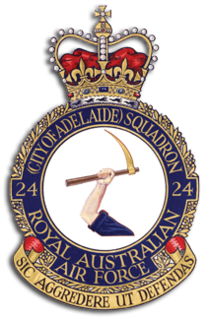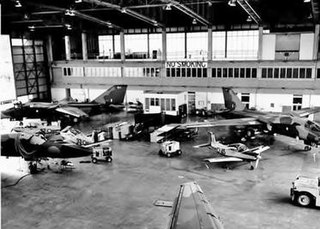
No. 38 Squadron was a Royal Australian Air Force (RAAF) transport and training unit active between 1943 and 2018. It was formed on 15 September 1943 and saw service during World War II transporting supplies and personnel between Australia and the combat zones in New Guinea and Borneo, using Douglas Dakota aircraft. Following the war, the squadron conducted regular courier flights between Australia and Japan in 1947 and 1948. No. 38 Squadron was deployed to Singapore from 1950 to 1952, supplying Commonwealth forces engaged in the Malayan Emergency and undertaking courier flights across Asia. In 1954 it became responsible for training RAAF personnel to operate Dakotas.
No 85 Squadron was a Royal Australian Air Force (RAAF) fighter squadron which provided air defence to Western Australia during World War II. It was formed in 1943 and disbanded in 1945. The squadron did not see combat during the war, although it attempted to intercept Japanese aircraft on several occasions in 1943, without success.

No. 12 Squadron was a Royal Australian Air Force (RAAF) general purpose, bomber and transport squadron. The squadron was formed in 1939 and saw combat in the South West Pacific theatre of World War II. From 1941 to 1943, it mainly conducted maritime patrols off northern Australia. The squadron was based at Merauke in western New Guinea from November 1943 to July 1944, when it was withdrawn from operations. After being re-equipped, it operated as a heavy bomber unit from February 1945 until the end of the war. The squadron continued in this role until it was redesignated No. 1 Squadron RAAF in February 1948. The squadron was reformed in 1973 to operate transport helicopters but was again disbanded in 1989.

No. 24 Squadron is a Royal Australian Air Force squadron. The squadron was formed in 1940 and saw action as a bomber squadron during World War II serving in the Pacific theatre against the Japanese, and undertaking operations during the Battle of Rabaul, and the New Guinea, New Britain and Borneo campaigns. The squadron was disbanded in 1946 following the conclusion of hostilities, but was re-formed in 1951. From then until 2010 the squadron was an RAAF Reserve squadron located near Adelaide, South Australia; for part of this time, until 1960, the squadron continued to perform flying duties, before converting to a ground support role. In 2010, the squadron combined with Combat Support Unit Edinburgh to become a Permanent Air Force unit and it currently forms part of No. 96 Wing, Combat Support Group.

No. 60 Squadron was a Royal Australian Air Force fighter squadron of World War II. It was formed in January 1942 and disbanded three months later, without seeing combat.

No. 67 Squadron was a Royal Australian Air Force (RAAF) maritime patrol squadron of World War II. It was formed in January 1943, conducted patrols off the southern Australian coastline until the end of the war, and was disbanded in November 1945.

No. 102 Squadron was a Royal Australian Air Force (RAAF) heavy bomber squadron of World War II. The squadron was only active for less than nine months before being disbanded. No. 102 Squadron was formed at Cecil Plains, Queensland on 31 May 1945. The Squadron's B-24 Liberator bombers arrived in July. While the Squadron began training on these aircraft, the war ended before it reached operational status. Following the end of the war the squadron operated in the transport role until December 1945. No. 102 Squadron was disbanded on 19 March 1946.

No. 78 Wing is a Royal Australian Air Force (RAAF) operational training wing, headquartered at RAAF Base Williamtown, New South Wales. It comprises Nos. 76 and 79 Squadrons, operating the BAE Hawk 127 lead-in fighter, and No. 278 Squadron, a technical training unit. No. 79 Squadron, located at RAAF Base Pearce, Western Australia, is responsible for converting new pilots to fast jets, while No. 76 Squadron at Williamtown conducts introductory fighter courses; both units also fly support missions for the Royal Australian Navy and the Australian Army.

No. 82 Wing is the strike and reconnaissance wing of the Royal Australian Air Force (RAAF). It is headquartered at RAAF Base Amberley, Queensland. Coming under the control of Air Combat Group, the wing operates F/A-18F Super Hornet multirole fighters and Pilatus PC-9 forward air control aircraft. Its units include Nos. 1 and 6 Squadrons, operating the Super Hornet, and No. 4 Squadron, operating the PC-9.

No. 21 Squadron is a Royal Australian Air Force (RAAF) general reserve squadron. Formed in the mid-1930s as a unit of the part-time Citizen Air Force (CAF), it was mobilised for service during World War II, when it saw action against the Japanese as a fighter unit in the Malayan campaign, a dive bomber unit in the New Guinea campaign, and a heavy bomber unit in the Borneo campaign. After the war, the squadron continued to fly until 1960, when the CAF ceased flying operations. At that time, No. 21 Squadron converted to a non-flying support role, which it currently fulfils at RAAF Williams.

No. 71 Squadron was a Royal Australian Air Force (RAAF) maritime patrol squadron of World War II. It was formed in January 1943 and conducted patrols off the east coast of Australia until it was disbanded in August 1944.
No. 462 Squadron is a Royal Australian Air Force (RAAF) squadron which forms part of the Information Warfare Directorate in the RAAF's Air Warfare Centre. The squadron was first formed in 1942 as a heavy bomber unit and saw combat in this role in the Mediterranean area until it was disbanded in March 1944. It was reformed in the United Kingdom in August 1944 to participate in the bombing campaign against Germany, and in December that year converted to a specialist electronic warfare unit. No. 462 Squadron continued in this role until the end of the European war in May 1945 and was disbanded in September that year. The squadron was reformed in its current role during April 2005.

The Berlin Airlift Squadron was a Royal Australian Air Force (RAAF) transport squadron formed to participate in the Berlin Airlift. The unit operated for one year, between August 1948 and August 1949, and was raised specifically for the operation, drawing crews from two existing RAAF transport squadrons. It flew more than 2,000 sorties during the airlift, without loss.

No. 7 Squadron was an Australian flying training squadron of World War I and medium bomber squadron of World War II. The squadron was formed in England in October 1917 as part of the Australian Flying Corps, and disbanded in early 1919. It was re-formed by the Royal Australian Air Force on paper in June 1940, and operationally in January 1942. After seeing action during the Pacific War flying Lockheed Hudson and, later, DAP Beaufort bombers, the squadron was disbanded a second time in December 1945.

No. 8 Squadron was an Australian flying training squadron of World War I and medium bomber squadron of World War II. The squadron was formed in England in October 1917 as part of the Australian Flying Corps, and disbanded in April 1919. It was re-formed by the Royal Australian Air Force in September 1939. After seeing action during the Pacific War flying Lockheed Hudson and, later, DAF Beaufort bombers, the squadron was disbanded a second time in January 1946.

No. 82 Squadron RAAF was a Royal Australian Air Force fighter squadron that operated during World War II and its immediate aftermath. It was formed in June 1943, flying Curtiss P-40 Kittyhawks and, initially, Bell P-39 Airacobras from bases in Queensland and New Guinea. The squadron became operational in September 1944, and undertook ground attack missions against Japanese targets in the Pacific theatre. Following the end of hostilities, No. 82 Squadron was re-equipped with North American P-51 Mustangs and deployed to Japan, where it formed part of the British Commonwealth Occupation Force. It remained there until October 1948, when it was disbanded.

No. 8 Service Flying Training School was a flying training school of the Royal Australian Air Force (RAAF) that operated during World War II. It was formed in December 1941, and graduated its first course in March 1942. Responsible for intermediate and advanced instruction of pilots under the Empire Air Training Scheme (EATS), the school was based at RAAF Station Bundaberg, Queensland, and operated Avro Anson aircraft. It spawned two maritime patrol squadrons in early 1943, raised in response to increased Japanese submarine activity off Australia's east coast. Some of the school's aircraft were also attached to the Australian Army in 1944–45. No. 8 SFTS completed its final training course in December 1944, and was disbanded in July 1945.

No. 482 Squadron was a maintenance unit of the Royal Australian Air Force (RAAF). It was formed in May 1942 as No. 4 Repair and Salvage Unit, renamed No. 4 Repair and Servicing Unit in January 1945 and re-formed as No. 482 (Maintenance) Squadron in May 1946. The squadron then became a component of No. 82 (Bomber) Wing at RAAF Station Amberley, Queensland. Over the years it serviced the wing's Consolidated B-24 Liberators, Avro Lincolns, English Electric Canberras, McDonnell Douglas F-4E Phantoms, and General Dynamics F-111Cs. No. 482 Squadron merged with No. 3 Aircraft Depot to form No. 501 Wing in March 1992. No. 501 Wing continued to provide maintenance and logistics support for the F-111Cs at Amberley until disbanding in 2001.

No. 1 Operational Conversion Unit (No. 1 OCU) was an operational training unit of the Royal Australian Air Force (RAAF). Formed in January 1959 at RAAF Base Amberley, Queensland, its role was to convert pilots and navigators to the English Electric Canberra bombers flown by Nos. 1, 2 and 6 Squadrons. The unit's complement of Canberras included T.4 and Mk.21 dual-control trainers, and Mk.20 bombers. Originally a component of No. 82 Wing, No. 1 OCU became an independent unit at Amberley in April 1968, its focus being the provision of operationally ready pilots for service with No. 2 Squadron in the Vietnam War. No. 1 OCU was disbanded in June 1971, following the withdrawal of No. 2 Squadron from South-East Asia. By then the RAAF's only Canberra unit, No. 2 Squadron ran its own conversion courses before disbanding in 1982.

























